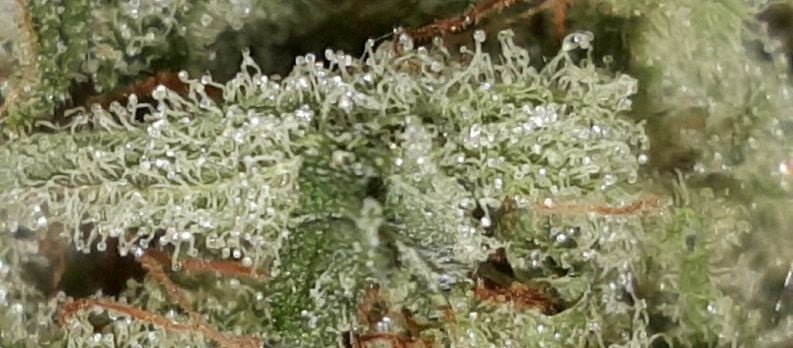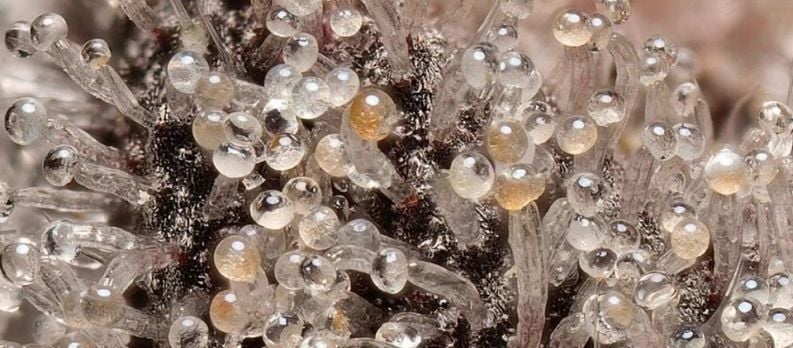
Trichomes are small resinous glands that cover the buds and leaves or epiderma of cannabis plants. Looking like tiny frosty hairs when looking at them with the naked eye and like tiny mushrooms when looking at them under a microscope, trichomes are considered to be a sign of good, potent and flavourful buds.
Coming from a Greek word “Tríchōma” meaning “growth of hair”, trichomes are defined as “fine outgrowths or appendages on plants, algae, lichens, and certain protists”. Trichomes are found on many other plants other than cannabis and their function varies from plant to plant but their function is in most cases self-defense from various elements, pest or diseases.
Some of most notable trichome functions on other plants include:
- “the stinging” and the rash from the stinging nettle, which is a result from trichomes injecting chemicals onto your skin
- the rash and the itching from the Poison Ivy plant comes as a result of trichome releasing chemicals in self defense
- trichomes on the Venus Fly Trap help it to catch its prey due to their stickiness
- aromas, smell and bitter taste coming from trichomes on various other plants acts as a deterrent for various pests and insects while trichomes themselves block them from psychically reaching the plant matter
Function Of Trichomes On Cannabis
Like on most other plants, the function of trichomes on cannabis plants is to help it defend itself against all harm, whether coming from harmful UV sun rays, wind, dust particles, insects, pests or disease.
To combat all those threats, the trichomes on cannabis plants are loaded with all kinds of chemical compounds like – cannabinoids, flavonoids, terpenes and others, that help with that fight. Chemical compounds called vacuoles and plastids, each with its own effect and function, are made in the ‘stalks’ of the trichomes which then travel up to the trichome heads or glands, where when exposed to UV light, they form cannabinoids. Although having a lot of trichomes on your plants is usually a good indicator of good potency and quality of your buds, it doesn’t necessarily have to be so in all cases.
Types Of Trichomes
Although there are many different types of trichomes, three that are most commonly found on cannabis plants are:
- Bulbous trichomes – with their size ranging just from 10 to 30 micrometers, they are the tiniest of three and appear on the surface of the whole plant but they aren’t visible without the use of a microscope or some other kind of magnifier, as they are comprised by just a few cells forming a stalk and a gland head. As this gland swells with resin, it usually forms a “bulbous” end on top of the membrane from which they got their name
- Capitate-sessile trichomes – with sizes from 25 to 100 micrometers, they are very similar to previously mentioned ones with a slight difference – more cells, usually 8-16 form a larger, round gland that resembles a convex rosette and just one cell forms the stalk. They are both larger and more abundantly found on cannabis plants
- Capitate-stalked trichomes – the largest of three, with sizes going from 50 to 500 micrometers, they have the most complex structure out of three. Both the stalks and the heads have multiple cells which are loaded with highest concentrations of all chemical compounds, making them visible even by the naked eye.

Although they come in various shapes and sizes, all three types of trichomes produce same cannabinoids, terpenes, flavonoids and the rest of compounds that are responsible for potency, aroma and taste of our cannabis plants. Depending on their genetics, different strains have different mixtures of all of those, making each strain a bit special and unique – both expressed by our senses and by their medical effects and properties.
Different environmental parameters such as light, temperature and soil composition can make for considerable differences in terpene profiles and/or potency of the same strain. Different light spectrums, PH and lower or warmer temperatures and geographic position can make the same strain have different terpene and cannabinoid levels.
Color Of Trichomes As An Indicator For Harvest
By looking at the trichomes and their progress growers can easily and accurately determine when is the optimal time for harvesting their plants. We want to harvest at peak maturity, ensuring for best potency, taste and aroma. Besides cannabinoids, that give the strain most of its medical properties, terpenes and flavonoids give them smell, aroma and taste. All of those mature with time and after they’ve reached their peak, they start to degrade or convert into other compounds. Some cannabinoids turn into others while more volatile molecules such as terpenes break apart when peak maturity is reached, so we want to harvest before that happens.
As cannabis plants go through flowering, trichomes will go from being transparent or opaque to being cloudy white. When they turn from cloudy white to milky white it means that they have reached peak maturity. After they’ve gone milky white, they will start turning amber, which means that they’ve passed peak maturity and that the decomposition process has started.
Because not all buds are exposed to the light the same way and they don’t get the same amounts of light, depending on their position on the plant or a branch – they will mature at different times. Generally, buds that are higher to the top and get more exposure, will finish sooner, so some growers like to harvest partially, leaving the lower, covered buds for an extra few days to ensure that they have matured fully too.
As flowers growing on different parts of the plant mature differently, so do trichomes on different parts of the bud. Those that are exposed to more light mature faster than the ones that might be covered or in light shadow.
It’s very hard to get all buds to be at peak maturity and same level of maturity when harvesting. Many growers tend to harvest when all trichomes have reached maturity, meaning when they are all milky white. Usually that doesn’t happen because, for the underdeveloped bud trichome to be milky white and at peak maturity that usually means that the buds that are more developed will have amber ones. Usually, when 10-25% of trichomes are amber and the rest are milky white is the optimal time to harvest. Having more transparent and less amber trichomes will give you a more of a energetic type of high while having more amber trichomes will give you a more of a relaxing, couch locked type of stoned feeling. When trichomes become amber in color THC in the plant starts turning into CBN, which isn’t psychoactive but provides users with that calming, sleepy effect. If you want to harvest for maximum CBD, you should not wait for the trichomes to go amber and you should harvest when most are white with some still transparent.
Preserving The Trichomes
Because of their gentle structure and volatile nature of essential oils containing cannabinoids, terpenes and flavonoids, it’s important to take good care of trichomes and limit their degradation or destruction. Exposure to light, high temperatures and oxygen can all damage the trichomes, as well as physical agitation or just passing of time, so one should be careful when handling both live plants and dried buds in order to minimize the risks.
Proper drying and curing will ensure that the trichomes aren’t damaged and minimize their degradation. If stored properly, under right conditions, your buds and the trichomes on them could last you months or even a couple of years. In order to extend the “shell life” of your cannabis and all the compounds in them, various extraction methods could be used. It could be simple as mechanical sifting and gathering of kief or making of hash, or one could use various solvent and solventless extraction methods using butane, alcohol or CO2. Those extracts and concentrates like rosin, shatter, vax or oils have much longer shelf life than the flowers themselves and if stored in proper conditions they could last indefinitely.
Why not head on over to The Vault Cannabis Seeds Store now and pick up some Cannabis Seeds, whilst taking advantage of the discount code VAULT15 for a whopping 15% discount off your order of Cannabis Seeds.
Newsletter Sign Up
Make sure you never miss another Vault promo – sign up for our newsletter at http://goo.gl/Bt2Ba2
Remember: It is illegal to germinate cannabis seeds in many countries and some remote, less enlightened planets outside the core systems. It is our duty to inform you of this fact and to urge you to obey all of your local laws to the letter. The Vault only ever sells or sends out seeds for souvenir, collection or novelty purposes.

